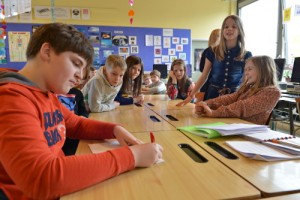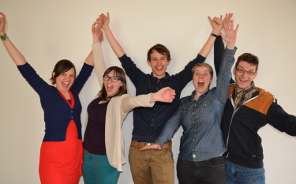Kids help researchers deliver better presentations
On May 8th, the Science Battle will take place. Researchers will be presenting their work to elementary school children. Out of 24 submissions, the children selected 5 proposals they thought were particularly compelling.

An event for kids, you may be thinking.
Not so fast. This could actually be much more relevant to you than it may seem. Would you like to improve your presentation skills? Then do keep reading. No audience is better at pushing researchers out of their comfort zone than grade schoolers.
I have simply been blown away by the immense amount of enthusiasm, professionalism and creativity. And that goes for both the children and the scientists. There is simply an incredible thirst for knowledge during these events.
During the event, the researchers get 15 minutes to present their work to children ages 6 through 12. They battle for the coveted science trophee. Judges from the fifth and sixth grades have the final say in who wins.
What can we learn from the voting outcomes?
1. Health and technology are popular
Three out of five selected topics were related to health, and two were related to technology.
Does speaking about health require that person to be medically trained? Not at all. Sara Vleminckx studies wasps, but found a connection with inflammation. Koen van den Eeckhout’s field of expertise is lighting, but uses that knowledge to track down medications inside the body.
Even if there is no link with health right now, there may be one in the future. Jeroen Peeters is well aware of this. His heat-sensitive camera can even detect cancerous cells, he writes. The relevance of his research becomes very clear immediately.
2. Clear language
The topics that were selected were written in clear, non-technical language. It works for children, but adults prefer this too.
For example, take a look at Hetty Helsmoortel’s proposal about leukemia:
‘Ik onderzoek waarom bepaalde kinderen leukemie krijgen en andere helemaal niet. Daarvoor ga ik op zoek naar de slechteriken in het bloed van zieke kinderen. Dat doe ik door iets heel spectaculairs te doen: met onze machines duik ik helemaal in de bloedcellen van zieke én gezonde mensen om daar rond te neuzen. Mijn taak bestaat erin om de boosdoener te vinden. Niet altijd gemakkelijk, want meestal zit die héél goed verstopt! Wanneer ik hem uiteindelijk gevonden heb, zullen andere mensen medicijnen ontwikkelen om hem uit te schakelen en de kinderen te laten genezen.’
Ik daag je uit om jouw onderzoek zo helder en beeldend te beschrijven. Verkleuterend? Kan zijn, maar ik doe graag een test bij 100 volwassenen. Zeker weten dat iedereen de boodschap zal vatten. En daar gaat het toch om als je communiceert naar een breed publiek?
3. Make a show out of it (and announce it as such)
If you are facing the choice between several suggested topics, you want to get an idea for what you’ll be seeing. An interesting topic alone is not enough to persuade anyone. The researchers who made the cut all clearly described the show they had in mind for the event.
Jeroen Peeters, for example, told the kids up front what all can be seen through a heat-sensitive camera. “You may not be aware, but we all leave a trace of heat behind. (…) And if you’d like to find out how you can communicate in a secret language by just using your finger, I’d be happy to show you!
Leverage things that trigger the imagination of your audience. Make it as concrete as possible, and make your potential audience visualize the brilliance of what you’ll be presenting.
Children are the best coaches

Teacher Inge of the Prins Boudewijn elementary school told me that the children take their role as judges very seriously. “They are very critical. If they sense that they are being manipulated into voting for a particular presenter, they will give that person a lower score.”
The children asked questions about each of the 5 chosen topics prior to the presentations. One student asked whether CO2 could be detected with the heat-sensitive camera, “because isn’t CO2 a form of heat as well?”. Do not underestimate these kids!
I spoke with several of the teams involved in the upcoming Science Battle. One of them suggested to have scores between 5 and 10. “It’s just like a score between 1 and 5, but we feel bad if we have to give a speaker less than a 5”. Great idea, right? Schools should apply this in their scoring system!
– – –
No doubt about it. Kids can improve your presentation skills. Try it out!